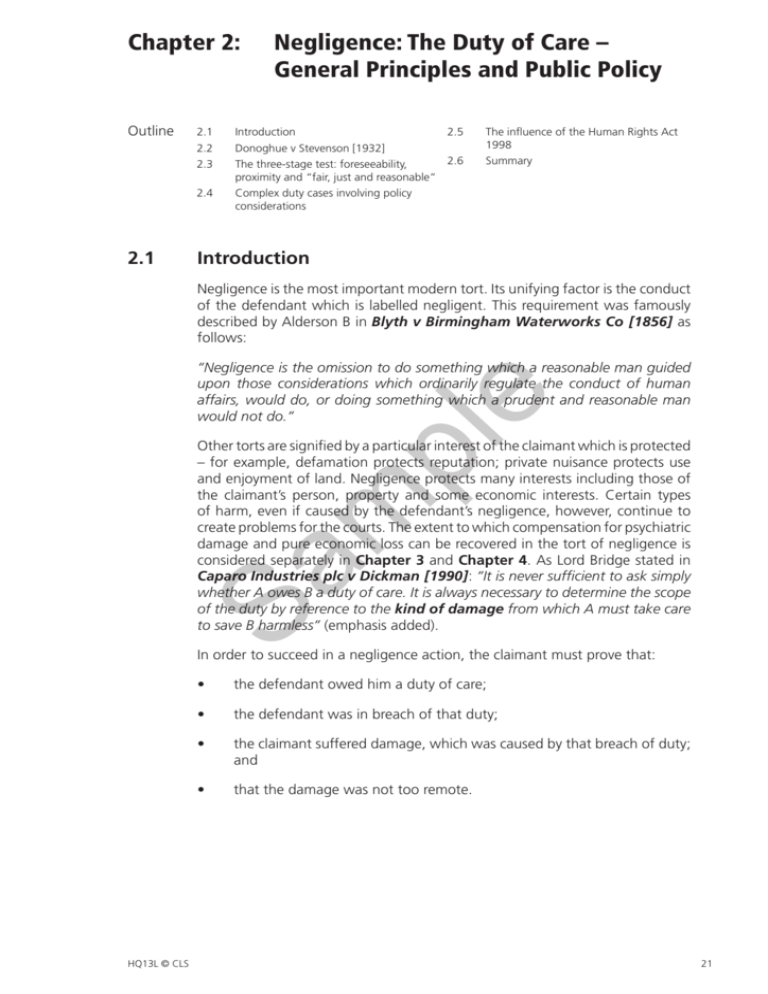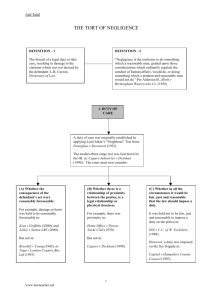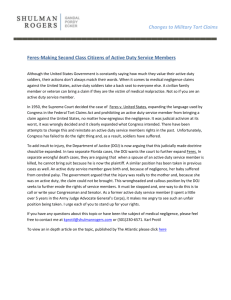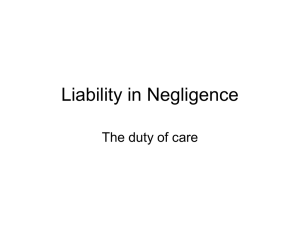
Chapter 2:
Outline
2.1
Negligence: The Duty of Care –
General Principles and Public Policy
2.1
Introduction
2.5
2.2
Donoghue v Stevenson [1932]
2.3
2.6
The three-stage test: foreseeability,
proximity and “fair, just and reasonable”
2.4
Complex duty cases involving policy
considerations
The influence of the Human Rights Act
1998
Summary
Introduction
Negligence is the most important modern tort. Its unifying factor is the conduct
of the defendant which is labelled negligent. This requirement was famously
described by Alderson B in Blyth v Birmingham Waterworks Co [1856] as
follows:
pl
e
“Negligence is the omission to do something which a reasonable man guided
upon those considerations which ordinarily regulate the conduct of human
affairs, would do, or doing something which a prudent and reasonable man
would not do.”
Sa
m
Other torts are signified by a particular interest of the claimant which is protected
– for example, defamation protects reputation; private nuisance protects use
and enjoyment of land. Negligence protects many interests including those of
the claimant’s person, property and some economic interests. Certain types
of harm, even if caused by the defendant’s negligence, however, continue to
create problems for the courts. The extent to which compensation for psychiatric
damage and pure economic loss can be recovered in the tort of negligence is
considered separately in Chapter 3 and Chapter 4. As Lord Bridge stated in
Caparo Industries plc v Dickman [1990]: “It is never sufficient to ask simply
whether A owes B a duty of care. It is always necessary to determine the scope
of the duty by reference to the kind of damage from which A must take care
to save B harmless” (emphasis added).
In order to succeed in a negligence action, the claimant must prove that:
HQ13L © CLS
•
the defendant owed him a duty of care;
•
the defendant was in breach of that duty;
•
the claimant suffered damage, which was caused by that breach of duty;
and
•
that the damage was not too remote.
21
Negligence: The Duty of Care – General Principles and Public Policy
The claimant may have certain defences raised against him, for example, the
allegation that he was contributorily negligent.
Any claimant in a negligence action must overcome certain legal “hurdles”
in order to establish that the tort of negligence has been committed. If the
claimant knocks over any of the hurdles, his claim fails.
Duty of care owed
by the defendant to
the claimant
pl
e
Breach of duty of
care
Damage caused to
the claimant by the
breach
Sa
m
Damage not too
remote in law
Finish tape
2.1
Laura met with some of her girlfriends on a Friday night
and had a good few drinks. She decided to drive home,
even though she knew that she was drunk. On the way, she
lost control of her vehicle and crashed into her neighbour’s
parked car. In this example, it is clear that Laura owes a
duty to all road users, including people who have their
cars parked in the street, to take care not to damage their
property. Laura is in breach of that duty because she failed
to exercise the level of care that a reasonably prudent driver
would have exercised. The neighbour’s damage was caused
by Laura’s breach and it is one of the kinds of damage that
tort law generally compensates (the other kind, of course,
is personal harm). So Laura will be liable to her neighbour
in negligence.
22
HQ13L © CLS
Negligence: The Duty of Care – General Principles and Public Policy
In an increasingly litigious society, many claimants try to find a culpable
defendant to recompense them for injuries sustained. An extreme example
of such an attempt can be found in Vellino v Chief Constable of Greater
Manchester [2002]. The claimant, who was well known to the police, had a
history of trying to escape from his flat by jumping out of a window whenever
the police came to arrest him. On one such occasion he sustained serious
physical injuries which he claimed were attributable to a breach of the duty
of care on the part of the arresting officers, by failing to prevent him from
jumping out of the window! The Court of Appeal came to a majority decision –
one of the judges preferring the argument that a known risk created a duty to
take steps to guard against it happening. The majority held that no duty of care
existed in these circumstances. In addition, the claimant could be met with the
defence of ex turpi causa (see 7.5) because the attempt to escape from custody
was a criminal offence in itself.
pl
e
To be actionable in tort, the defendant’s lack of reasonable care must occur in
the context of a duty to take care. In English law there is no code or individual
statute to which a judge can turn, which will inform him whether the law
recognises the existence of such a duty of care between the defendant and the
claimant who are the parties to the action he is asked to judge.
Sa
m
Many duty relationships have been recognised by the courts for a very long
time – for example, one highway user to another, doctor to patient, employer
to employee and manufacturer to those affected by his product. In the main,
such duties of care have been identified in the courts with Parliament playing a
very limited role. The content of this chapter is dominated by the development
of the common law through judicial reasoning.
(5)
2.2
What must every claimant prove in a negligence action?
Donoghue v Stevenson [1932]
Not every negligent act will result in liability in negligence. There has to be
some control device in order to determine when liability is capable of arising.
This function is performed by the duty of care. When a case reaches court the
judge may have to determine whether the defendant owed the claimant a duty
to take reasonable care in the circumstances in which the claimant alleges the
defendant was negligent.
Before 1932, there was no recognised general test for determining whether a
duty existed in circumstances which had not previously come before a court.
Although the rapid speed of change brought about by the Industrial Revolution
in the 19th century made such a test necessary, the dominance of contract
law at that time meant that the development of tort was subdued. An early
attempt to develop a test occurred in Heaven v Pender [1883], but the most
famous attempt came in Donoghue v Stevenson [1932]. The date of the
case is significant as it marks a step away from the laissez-faire basis of contract
law to the more collectivist approach of tort.
HQ13L © CLS
23
Negligence: The Duty of Care – General Principles and Public Policy
2.2.1
The neighbour principle
In Donoghue v Stevenson, a friend of the claimant purchased a bottle of
ginger beer in an opaque bottle. The claimant poured half of the ginger beer
into a glass and drank it. She then poured the remainder into the glass and
saw what she claimed to be the remains of a decomposed snail drain out
from the bottom of the bottle. She claimed to have suffered illness as a result.
She sued the manufacturer of the ginger beer in negligence as she had no
contract with either the retailer or the manufacturer. The House of Lords (by a
bare majority of 3:2) established that a manufacturer of products owed a duty
to take reasonable care to the ultimate consumer of the product. Lord Atkin
stated his famous “neighbour principle” test as a device to determine when a
duty of care is owed.
pl
e
“You must take reasonable care to avoid acts or omissions which you can
reasonably foresee would be likely to injure your neighbour. Who then, in
law, is my neighbour? The answer seems to be – persons who are so closely
and directly affected by my act that I ought reasonably to have them in
contemplation as being so affected when I am directing my mind to the acts or
omissions which are called in question.”
2.2.2
m
This statement of legal principle forms the basis of the modern law of
negligence. It is an attempt to provide a test which both explains why duties
of care have been recognised in the past and enables judges to deal with novel
situations in the future.
Developments after 1932
Sa
The test based on reasonable foreseeability of damage did not find immediate
acceptance with the judiciary and expansion of duty areas was limited until the
1960s.
In Home Office v Dorset Yacht Co Ltd [1970] the House of Lords expressly
approved Lord Atkin’s statement and gave impetus to the development
of negligence. Lord Reid said that, although the neighbour principle would
“require qualification to meet new circumstances . . . the time has come when
we can and should say that it ought to apply unless there is some justification
or valid explanation for its exclusion”. This was confirmed by the House of
Lords in Anns v Merton London Borough Council [1978]. Lord Wilberforce
approached the question whether a duty should be recognised in two stages
(see the chart at 2.3).
This two-stage test proved to be the high-water mark of negligence. Its use
led to a considerable expansion in the areas covered by negligence and, in
particular, took the tort into the area of recovery of pure economic loss caused
by negligent conduct which had previously been thought to be the exclusive
province of the law of contract (see Chapter 4). Inevitably, this expansion
provoked criticism and the judiciary itself questioned the value of the test. A
good example of this critical approach can be found in the words of Lord Keith
of Kinkel in Yuen Kun Yeu v Attorney-General for Hong Kong [1988]:
“Their Lordships consider that for the future it should be recognised that the
two-stage test in Anns is not to be regarded in all the circumstances as a
24
HQ13L © CLS
© 2015 Copyright CILEx Law School Limited
All materials included in this CLS publication are copyright protected.
All rights reserved.
Any unauthorised reproduction or transmission of any part of this
publication, whether electronically or otherwise, will constitute an
infringement of copyright. No part of this publication may be lent, resold
or hired out for any purpose without the prior written permission of
CILEx Law School Ltd.
e
WARNING: Any person carrying out an unauthorised act in relation
to this copyright work may be liable to both criminal prosecution
and a civil claim for damages.
pl
This publication is intended only for the purpose of private study. Its
contents were believed to be correct at the time of publication or any
date stated in any preface, whichever is the earlier.
Sa
m
This publication does not constitute any form of legal advice to any person
or organisation.
CILEx Law School Ltd will not be liable for any loss or damage of any
description caused by the reliance of any person on any part of the
contents of this publication.
Published in 2015 by:
CILEx Law School Ltd
College House
Manor Drive
Kempston
Bedford
United Kingdom
MK42 7AB
British Library Cataloguing in Publication Data
A catalogue record for this manual is available from the British Library.
ISBN 978-1-84256-842-2









